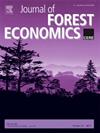Specifying Forest Sector Models for Forest Carbon Projections
IF 0.7
4区 农林科学
Q3 ECONOMICS
引用次数: 7
Abstract
Forest sector models merge models of timber inputs and final wood products markets with biophysical models of forest dynamics to project forest futures. Comprehensive treatment of biophysical dynamics is required to address the product detail of timber markets and to track changes in forest carbon. We examine assumptions for existing Forest Inventory Projection Models and empirically examine the implications for forest carbon projections. We compare model results with observations from remeasured forest inventories in the eastern United States. Results show forest carbon projections are sensitive to non-harvest disturbances, ownership, and stand-origin. Additionally, bias can arise when forest carbon stocks are estimated using correlations between average stock density and biomass aggregates. Current forest inventories provide a dataset of consistently remeasured forest plot records that will increasingly support a strong empirical foundation for Forest Inventory Projection Models.为森林碳预测指定森林部门模型
森林部门模型将木材投入和最终木制品市场模型与森林动态的生物物理模型相结合,以预测森林的未来。需要对生物物理动力学进行综合处理,以处理木材市场的产品细节和跟踪森林碳的变化。我们检验了现有森林清查预测模型的假设,并对森林碳预测的影响进行了实证检验。我们将模型结果与美国东部重新测量的森林清单的观测结果进行了比较。结果表明,森林碳预估对非采伐干扰、所有权和林分来源敏感。此外,当使用平均储量密度和生物量团聚体之间的相关性来估计森林碳储量时,可能会产生偏差。目前的森林清查提供了一个持续重新测量森林样地记录的数据集,这将日益为森林清查预测模型提供强有力的经验基础。
本文章由计算机程序翻译,如有差异,请以英文原文为准。
求助全文
约1分钟内获得全文
求助全文
来源期刊

Journal of Forest Economics
农林科学-林学
CiteScore
1.70
自引率
0.00%
发文量
16
审稿时长
>36 weeks
期刊介绍:
The journal covers all aspects of forest economics, and publishes scientific papers in subject areas such as the following:
forest management problems: economics of silviculture, forest regulation and operational activities, managerial economics;
forest industry analysis: economics of processing, industrial organization problems, demand and supply analysis, technological change, international trade of forest products;
multiple use of forests: valuation of non-market priced goods and services, cost-benefit analysis of environment and timber production, external effects of forestry and forest industry;
forest policy analysis: market and intervention failures, regulation of forest management, ownership, taxation;
land use and economic development: deforestation and land use problem, national resource accounting, contribution to national and regional income and employment.
forestry and climate change: using forestry to mitigate climate change, economic analysis of bioenergy, adaption of forestry to climate change.
 求助内容:
求助内容: 应助结果提醒方式:
应助结果提醒方式:


